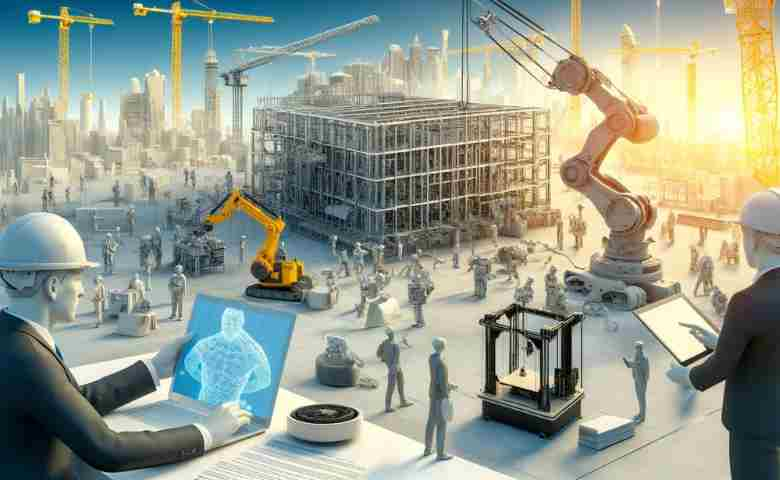Last Updated on May 19, 2024 by Admin
Building construction is an activity that has existed and evolved for millennia, from the Stone Age to the present day. New technologies have been introduced and improved upon during various periods, but never has there been such a rapid progression as in recent times. From robots to 3D printers, new technologies are being integrated into the construction process virtually daily.
Table of Contents
What is the Future of Building Construction?
The future of building construction is dynamic and filled with potential. Though it’s difficult to predict with absolute certainty, some clear trends are shaping the industry profoundly. Technology stands out as a major driver of change, offering tools and methods that could revolutionize how we build.
Emerging Technologies in Construction
3D Printing
One of the most promising technologies is 3D printing. This innovation has already been used to create entire houses and its usage is likely to grow. 3D printing can significantly reduce construction time and costs while allowing for highly complex and customized designs. For example, ICON’s 3D printed homes are making waves in affordable housing solutions.
Prefabrication
Another trend is the increasing use of prefabricated components. Prefabrication has become quite popular in countries like Japan, where space is limited. Construction time can be greatly reduced by manufacturing and assembling components in factories and assembling them on-site. This method also leads to less waste and fewer errors, exemplified by companies that specialize in off-site construction.
Sustainable Building Technologies
Technology is also making buildings more sustainable. Innovations such as advanced solar panels, smart thermostats, and energy-efficient materials are becoming more common. Companies are at the forefront of integrating solar technology into residential and commercial buildings, promoting sustainability.
Real Estate Technology: Video Tours, VR, and AR
The technology of tomorrow will change the way we build and sell homes. Imagine taking a video tour of a home before you buy it or seeing what your new home will look like before it’s even built. That’s the power of virtual reality (VR) and augmented reality (AR).
Real estate companies are already using VR to give potential buyers a realistic view of properties. With AR, developers can show buyers what a finished project will look like. This technology is revolutionizing how we think about construction and real estate. For instance, Matterport provides 3D virtual tours, making property viewing more immersive.
Construction Technology: Building Information Modeling (BIM)
Construction technology is constantly evolving, and one of the most exciting recent developments is Building Information Modeling (BIM).
BIM is a 3D model-based process that provides architects, engineers, and construction professionals with more accurate and efficient ways to plan, design, construct, and manage buildings and infrastructure. A recent study by McGraw Hill Construction found that 79% of survey respondents expect BIM to be widely used in their firms within the next three years.
Benefits of BIM
- Improved Coordination: BIM allows for better coordination between all the disciplines involved in a construction project. It can identify potential clashes between different systems before they occur, saving time and money during construction.
- Enhanced Decision-Making: BIM creates more realistic simulations of how a building will look and function once completed, improving decision-making during the design phase and quality control during construction.
Industry Trends in Technology for Construction Companies
The construction industry has seen significant technological advancements in recent years. Construction companies have had to adapt to new business ways to stay competitive. Here are some of the most important industry trends:
- Drones for Surveying and Mapping: Drones provide a bird’s eye view of construction sites, saving time and money by offering precise site assessments before work begins. Companies like DJI lead in providing drone technology for construction.
- Virtual Reality (VR): VR helps design by allowing architects and engineers to create and walk through virtual models of proposed buildings, identifying potential problems early on. Platforms like IrisVR are pioneering VR in construction.
- Mobile Apps: Mobile apps have increased in the construction industry, enhancing project management, time tracking, and overall efficiency. Apps like Procore and PlanGrid are indispensable tools for modern construction firms.
Emerging Trends: Robotics and Automation
Another trend shaping the future of construction is the use of robotics and automation. Robots can perform bricklaying, welding, and even intricate tasks like painting with high precision and consistency. Automation reduces labor costs and speeds up construction time. For example, Construction Robotics is developing robots like SAM (Semi-Automated Mason) to assist in construction tasks.
Conclusion
The building construction industry is on the cusp of significant change, with technology playing an ever-increasing role in how buildings are designed and constructed. This change will likely bring several benefits for construction companies and their clients, including increased efficiency, accuracy, and reduced costs. While challenges are associated with this transition, the building construction industry is well-positioned to take advantage of technology’s opportunities.
For further insights and the latest updates on construction technology, visit Construction Dive and Engineering News-Record.
Related Posts:
- Virtual Reality (VR) and Augmented Reality (AR) in Building Information Modeling (BIM): Transforming the AEC Landscape
- Virtual reality in Construction industry: All you need to know about
- What are the latest innovations in construction planning?
- The Ultimate Guide to Scan to BIM Technology


